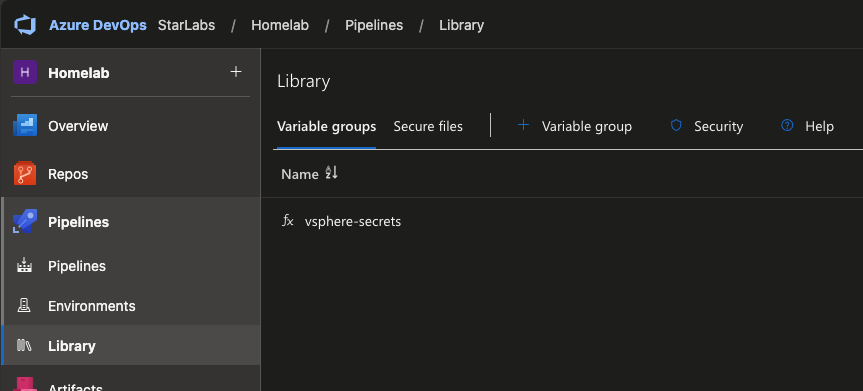Managing Secrets Securely in Azure DevOps Server with Variable Groups
Welcome to the next article in the Azure DevOps Server series. In this article, we’ll dive into what Variable Groups are, how they can be used securely in Azure DevOps Server, and walk through some practical examples.
In self-hosted DevOps environments, keeping secrets secure while maintaining flexibility can be a challenge. Let’s be honest, we are all guilty of hardcoding credentials in a local script to keep things simple and move fast. But that is not the proper way to do it and if you are using your homelab to level up your skills, better do it the right way since the beginning.
Azure DevOps Server offers a powerful yet often underutilized feature—Variable Groups—to help manage credentials, tokens, and configuration values safely across your pipelines.
What Are Variable Groups?
Variable Groups are collections of key-value pairs that can be shared across multiple pipelines within a project. These variables can include:
- Non-sensitive values (e.g., environment names, region codes)
- Secrets like passwords, tokens, and API keys
When a value is marked as a secret, Azure DevOps ensures that it is encrypted at rest and masked in logs.
Variable Groups are stored in the Azure DevOps Library and can be linked to both Classic and YAML pipelines. Although in my homelab I only use YAML pipelines.
Why Use Variable Groups?
Using Variable Groups in Azure DevOps Server helps:
- Promote DRY (Don’t Repeat Yourself) principles by centralizing shared configuration
- Simplify environment management (e.g., dev, staging, prod)
- Reduce risk by abstracting secrets out of pipeline code
- Allow controlled access through permission management
Creating a Variable Group in Azure DevOps Server
These steps apply to Azure DevOps Server 2020+, if you remember from my previous article I am running Azure DevOps Server 2022 in my homelab.
- Navigate to your project in Azure DevOps Server.
- Click Pipelines > Library.
- Select + Variable group.
- Name your group (e.g.,
vsphere-secrets). - Add variables:
vsphere_adminvsphere_password(check the “Keep this value secret” box)
- Click Save.
Using Variable Groups in Pipelines
In Classic Pipelines
- Edit your pipeline in the visual editor.
- Under Variables, click Variable groups.
- Click Link variable group and choose your group.
The variables will now be available in your tasks using the syntax:
$(variableName)
In YAML Pipelines
YAML pipelines in Azure DevOps Server (from 2020 onward) also support variable groups:
variables:
- group: vsphere-secrets
You must grant pipeline access to the variable group for YAML to use it.
Best Practices for Secrets Management
- Mark all sensitive values as secret.
- Use permissions on variable groups to control access.
- Consider storing secrets in a secure external store (like Azure Key Vault or Hashicorp Vault) and referencing them if your pipelines are hybrid cloud-based.
- Avoid echoing secret variables in logs, even accidentally (e.g.,
echo $(secret)).
YAML Pipeline to Deploy a VM in vSphere
Here is a sample Azure DevOps Server YAML pipeline that deploys a VM to vSphere from a template. You can trigger this pipeline manually from Azure DevOps Server web console, just why trigger is set to none. This assumes you have PowerCLI available in your self-hosted agent, more on self-hosted agents in the next article.
trigger:
- none
variables:
- group: vsphere-secrets
pool:
name: Default
steps:
- task: PowerShell@2
inputs:
targetType: 'inline'
script: |
$vcenter = "vcsa-01.starlabs.local"
$username = "$(vsphere_admin)$"
$password = '$(vsphere_password)'
$datacenter = "STARLABS"
$cluster = "LabCluster"
$template = "ubuntu-22"
$vmName = "ubuntu-deploy-$(Build.BuildId)"
$network = "WRK-DVPortGroup"
# Connect to vCenter
Connect-VIServer -Server $vcenter -User $username -Password $password
# Clone VM from template
New-VM -Name $vmName `
-Template $template `
-Datacenter $datacenter `
-VMHost (Get-Cluster $cluster | Get-VMHost | Sort-Object MemoryGB -Descending | Select-Object -First 1) `
-NetworkName $network `
-ResourcePool (Get-Cluster $cluster | Get-ResourcePool | Where-Object { $_.Name -eq "Resources" })
Write-Host "VM $vmName deployed successfully."
References
- Azure DevOps Server Documentation – Library Variable Groups
- Secrets in Azure Pipelines
- Secure pipeline secrets with permissions
- VMware PowerCLI Documentation
If you’re managing your own build infrastructure with Azure DevOps Server, Variable Groups are an indispensable tool for staying secure and scalable. Take the time to centralize secrets, enforce permissions, and eliminate credential sprawl across your pipelines.
In the next article I will cover self-hosted agents, what they are, how they work and how to deploy different types of self-hosted in you lab.
–Juanma


Comments